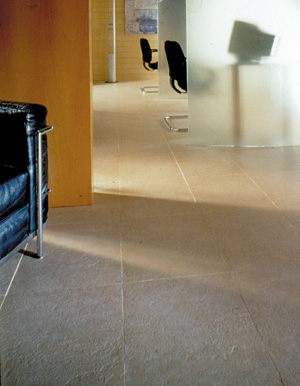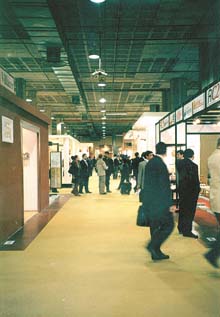

Despite recent events that have made many travelers wary, Cevisama's attendance this year increased by 13% -- including a 4% increase in U.S. visitors. Some exhibitors expressed the opinion that attendee enthusiasm and traffic were stronger at Cevisama than at Cersaie, the Italian ceramic tile industry's biggest trade show, last October.
According to ICEX, the Spanish Institute of Foreign Trade, Spanish tile companies exported nearly $1.5 billion of product during the first 10 months of 2001. That figure represents a 7.2% increase over the same period a year earlier.

In addition to highlighting sales trends, companies exhibiting at Cevisama identified key aesthetic trends taking hold in the U.S. ceramic tile market. According to Cesar Perez of Pamesa, the "king is always white" when Americans choose a tile color. The company's philosophy in approaching the American tile market in 2002, Perez added, is to "make it simple. Make it elegant." White and metallic hues, he projected, will be the major product trend in the U.S. marketplace for 2002.
Introductions by Tau and Gayafores reflected the traditionally conservative and monochrome color palette favored by the typical American consumer. Tau introduced the Solari collection, a frost-proof porcelain tile series that imitates stone. Designed for both interior and exterior applications, the 40-by-40-, 20-by-40- and 20-by-20-centimeter tiles are available in beige and gray. Complementary listellos and tacos are also available.

But not every Spanish tile producer opted to play it safe with the color palette. Guillermo Puente, managing director of Alcalagres, believes American consumers will expand their horizons in terms of color schemes.
Americans are "looking for something new," Puente said. While neutral colors -- such as beige and tan -- have traditionally been the most popular in the United States, darker colors are beginning to pick up in sales, he added. Examples of these darker colors are apparent in the new Volcano series from Alcalagres' Porcelanatto Integral collection.
Ceracasa also introduced darker hues in its Irta series of 12-inch-square through-body porcelain tiles. The rectified, semi-polished tiles in the collection are available in five colors.
Puente also said that larger formats are slowly but surely winning favor among American floor covering consumers. In the Northeast United States, 16-by-16-inch tiles have gained popularity, he said. And in Florida, 20-inch-square tiles have been selling well. Puente's observations were echoed by various exhibitors, including Juan Jose Benavent, director general of Metropol, a company that sells 15% of its products in the United States.
Although Americans' traditional predisposition for muted color choices in tile is well understood, that realization hasn't discouraged Spanish manufacturers from trying to expose U.S. consumers to a bolder, more fanciful palette. In fact, myriad product introductions exploded with color at this year's Cevisama.
Roca celebrated the 150th anniversary of Spanish architect Antoni Gaud? birth with the launch of a wall tile line that imitates the look and feel of Gaud? colorful and innovative architecture. Unfortunately, the vibrant line is not currently slated for release in the United States.
However, many colorful new introductions will be available in the United States. Saloni exhibited its Eternity High Gloss Collection. The bright white-body ceramic tile line is available in 18 colors and 8-by-8-inch and 4-by-4-inch formats for floors and walls, respectively.
While more muted than Eternity's High Gloss Collection, Plaza's Indico further demonstrates Spanish manufacturers' willingness to create more colorful U.S. product introductions. The Indico collection is available in 8-by-12-inch glazed ceramic wall tiles in four colors. The series features matching green and red mosaic tiles, marble listellos and trim pieces.
Diago Ceramicas' introduction of the Sahara series, from the Diago Gallery line, reflects another trend evident at Cevisama: textured tiles. The Sahara series is a ceramic tile line inspired by natural fibers. This offering was possibly one of the most unique products showcased at Cevisama. Similarly, Gres de Valls also released Textil, a glazed porcelain line designed to imitate carpet.

Cevisama 2002 also marked the launch of Greco Gres' innovative Venatto, a through-bodied extruded porcelain. Working with Italian technology, the Spanish company opened a plant in August 2001 to produce the patented product. Available in nine colors, the porcelain -- which takes five to seven hours to produce -- is made to be strong enough for use on stairs. According to Carmen Luna, Greco Gres' marketing manager, the company is currently looking for agents to represent the line in America.
Cevisama exhibitors and attendees gathered in Spain for one reason: to celebrate the growing worldwide popularity of tile. In the past year, American consumers begged for a wider, more sophisticated selection of ceramic tile and stone products. Foreign manufacturers have heard that call and have delivered a new generation of products that reflect the evolving tastes and trends of the U.S. market for 2002.
Report Abusive Comment